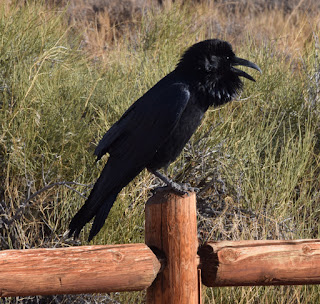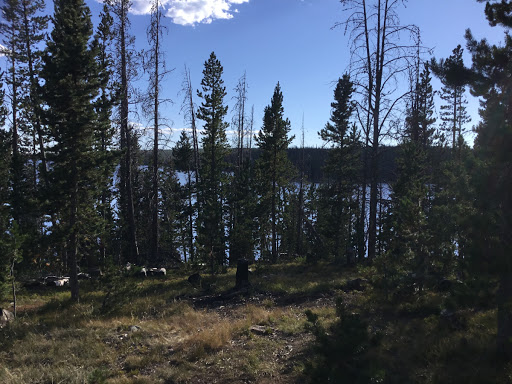On Sunday, we drove about 200 miles to
Fort Robinson State Park. Google took us through the wilds of
eastern Wyoming, including quite a bit of gravel road.
We arrived in Fort Robinson without
reservations, but were able to get a full hookup site. Fort
Robinson was built in the late 1800s, and used by the military until
after World War II. It became a state park in the 1950s. Normally
they would offer trail rides and a swimming pool, but all activities
were canceled due to Covid. We walked around the grounds, which
contain numerous old buildings now converted to lodging. We were
told that it is very popular for family reunions, and we can see why.


Richard had printed road trips from
DiscoverNebraska.com. On Monday, we decided to take the longest of
the road trips, largely on gravel or dirt roads. Our first stop was
at the Cheyenne Outbreak monument, commemorating when the Indians at
Fort Robinson broke out and tried to go back to their homeland. The
fighting killed 70 Indians and 11 soldiers, but ultimately the
survivors were taken back to Fort Robinson. We then went north to
Sowbelly Canyon. The name came from an Indian ambush that left the
soldiers trapped with nothing to eat but sow bellies; they escaped
after several days. This was very picturesque, with a small stream
running down it, and cliffs on both sides. We stopped at Coffey Park
for a picnic, a very pleasant spot.



We turned north near Harrison,
and headed into the Oglala National Grassland. This is ranch
country, and ranch homes are very far apart. We turned east, and
stopped at the church and cemetery in Montrose. The only house in
Montrose was falling down, but the church of the Immaculate
Conception was in very good condition. The church was open, and we
went in. We also walked around the cemetery. Across from the
church was the Warbonnet Battlefield, where the 5
th
Cavalry stopped a large group of Cheyenne who were attempting to link
up with Sitting Bull. The only casualty of the battle was the
Cheyenne Yellow Hair, killed and scalped by Buffalo Bill Cody, who
was a scout for the military.

Our next stop was Toadstool Geological
Park. We took a one mile hike through the badlands area. The
toadstools are not as impressive as those of Goblin State Park in
Utah. We continued on Toadstool road until we reached the paved road
north of Crawford. We got back to our camper around 5 PM, after
stopping at the gas station liquor store for beer.
It was a lot of driving on dirt and
gravel roads, and tiring. We resolved not to go as far on the next
day. Sandy cooked pork chops for dinner.
 |
| Death of Crazy Horse |
Tuesday was laid back; it was too hot
to hike. In the morning we went to the museum, which covered the
long history of the fort. Crazy Horse was killed here. The fort
was repurposed multiple times, including as remount facility for
training Army horses, and a German POW camp in WWII. The black
Buffalo Soldiers were here. In the afternoon we followed the White
River Road along the White River, which paralleled the old Chicago
and Northwestern railroad grade. We stopped at the Glenhaven
cemetery, with many graves from the early 1900s. We saw antelope and
turkeys, in a pretty valley. Sandi cooked shrimp kabobs for dinner.



On Wednesday, the weather was cool, so
we went for a hike. We drove up the Smiley Canyon road, and saw the
herd of bison. The road was blocked by a herd of horses, who may
have been hoping for a handout. We pulled forward slowly until the
horses moved out of the way; some of them may have gotten bumped by
the truck. The Turtle Rock trail goes from the Smiley Canyon road to
the top of the cliffs overlooking the valley, and back again. It was
a steady climb, with some nice views.
We decided to drive to the town of
Harrison to have lunch, as there were no picnic areas off the Smiley
Canyon road. After lunch, we noticed that the historical museum was
open, and decided to take a look. The cattle brand display in the
window drew our attention; the barb wire collection was excellent.
Our guide was a retired school teacher, who had taught at one room
school houses. We learned that Sioux county still had two one room
schools. The Harrison Hotel, built in 1886 as a railroad hotel, is
still open. We took a little tour. Sandi cooked bison burgers for
dinner. ;-)
On Thursday, we had hoped to do some
hiking, but the smoke was bad. In the morning, we visited the sites
of the Red Cloud Indian Agency, and the German POW Camp. We also
stopped at the museum bookstore to pick up some gifts. After a
lengthy nap by Richard, we drove to the Council Tree, the site of a
large council in 1875, during which the US government attempted to
buy the Black Hills from the Indians. We also drove up Soldier
Creek, to the end of the road, and found the small primitive
campground there.
On Friday, we decided to visit the
Crawford Livestock Market. We pulled our rig next to the stock
trailers and chatted with a cowboy named Ferguson, who went to the
University of Nebraska at Lincoln, “East Campus.” Richard took
some photos of the cattle being moved. Sandi did her best “Hi
y'all”, and mentioned that she had grown up on a farm. We did get
some heckling, and people asking us why we were there. They sell
thousands of cattle per week.
We drove east to Smith Falls State
Park, stopped in Valentine for provisions, and managed to make a
wrong turn. We got there about 6 PM, after losing an hour for the
time change. Our group started to show up, and we met some folks.
The campsites were huge, but no utilities. The park has bathrooms
and pay showers.


















































